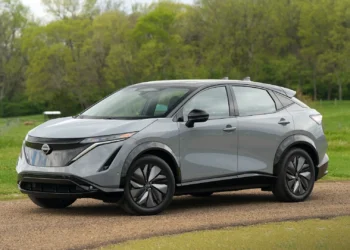Volvo says its upcoming EX30 electric SUV will have the lowest carbon footprint of any of its production models to date.
Scheduled to debut June 7, with orders and pre-orders in some markets on the same date, the EX30 will represent a 25% reduction in lifecycle carbon emissions versus the C40 Recharge and XC40 Recharge EVs—which both boast improved efficiency for the 2024 model year.
Electric cars have zero “tailpipe” emissions, but are still responsible for emissions from other sources, such as production and grid electricity used to charge them. According to a company press release, Volvo aims to tackle the former by looking at materials use.

Teaser for Volvo EX30 debuting on June 7, 2023
As the smallest vehicle in Volvo’s lineup, the EX30 will use less steel and aluminum in its construction—the two biggest contributors to production-related carbon dioxide emissions, the automaker claims. Much of the metal used will also be recycled, including about a quarter of the aluminum and 17% of the steel, according to Volvo.
In addition, 17% of the plastic in the EX30, ranging from interior components to the bumpers, is recycled. Volvo says that’s the highest amount of recycled plastic in any of its production cars to date. Other sustainable materials, including flax, and a wool blend with 70% recycled polyester, are used in the interior, along with denim trim made from recycled jeans.
Volvo is also looking to address energy use in the production process. The EX30 will be built in a factory powered by “high levels of climate-neutral energy, including 100% climate-neutral electricity,” according to the company. Volvo has also gotten 95% of Tier 1 suppliers (those that supply components directly to a vehicle manufacturer) for the EX30 to commit to 100% renewable energy use by 2025.

Teaser for Volvo EX30 debuting on June 7, 2023
The production process itself has also been streamlined to maximize material usage, Volvo claims. And at the end of its lifecycle, the EX30 is designed to be 95% recyclable.
Full details won’t be known until the EX30’s unveiling next month, but Volvo also told Autocar that there will be two battery options—a 51-kwh lithium iron phosphate pack and a 69-kwh nickel manganese cobalt pack. It’s unclear if both will be offered in the U.S., however.
Efforts made to reduce the carbon footprint of the EX30 are a step toward Volvo’s overall goal to cut its carbon footprint by 40% by 2025, compared to 2018 levels. That’s on the way to making only fully electric models by 2030. Every model in the automaker’s U.S. lineup now features some degree of electrification, but mild hybrids and plug-in hybrids make up the bulk of it.

Teaser for Volvo EX30 debuting on June 7, 2023
Volvo and sibling brand Polestar have been trend-setters in revealing the carbon footprint of their vehicles and transparency regarding methodology. But generally, across the market, lifetime CO2 keeps getting better for EVs.
Much of carbon footprint comes in the use stage, though. In the U.S., last year, the Supreme Court likely managed to grow the future carbon footprint of EVs in the U.S., by saying the EPA didn’t have full jurisdiction to regulate air pollution from power plants on a comprehensive market basis—and putting U.S. policy at odds with itself in light of EV investments.





